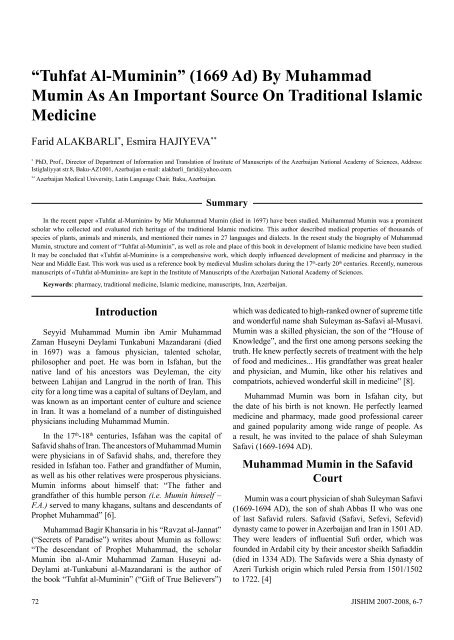Journal of International Society for the History
Journal of International Society for the History
Journal of International Society for the History
You also want an ePaper? Increase the reach of your titles
YUMPU automatically turns print PDFs into web optimized ePapers that Google loves.
“Tuhfat Al-Muminin” (1669 Ad) By Muhammad<br />
Mumin As An Important Source On Traditional Islamic<br />
Medicine<br />
Farid ALAKBARLI * , Esmira HAJIYEVA **<br />
* PhD, Pr<strong>of</strong>., Director <strong>of</strong> Department <strong>of</strong> In<strong>for</strong>mation and Translation <strong>of</strong> Institute <strong>of</strong> Manuscripts <strong>of</strong> <strong>the</strong> Azerbaijan National Academy <strong>of</strong> Sciences, Address:<br />
Istiglaliyyat str.8, Baku-AZ1001, Azerbaijan e-mail: alakbarli_farid@yahoo.com.<br />
** Azerbaijan Medical University, Latin Language Chair, Baku, Azerbaijan.<br />
Introduction<br />
Seyyid Muhammad Mumin ibn Amir Muhammad<br />
Zaman Huseyni Deylami Tunkabuni Mazandarani (died<br />
in 1697) was a famous physician, talented scholar,<br />
philosopher and poet. He was born in Isfahan, but <strong>the</strong><br />
native land <strong>of</strong> his ancestors was Deyleman, <strong>the</strong> city<br />
between Lahijan and Langrud in <strong>the</strong> north <strong>of</strong> Iran. This<br />
city <strong>for</strong> a long time was a capital <strong>of</strong> sultans <strong>of</strong> Deylam, and<br />
was known as an important center <strong>of</strong> culture and science<br />
in Iran. It was a homeland <strong>of</strong> a number <strong>of</strong> distinguished<br />
physicians including Muhammad Mumin.<br />
In <strong>the</strong> 17th-18th centuries, Isfahan was <strong>the</strong> capital <strong>of</strong><br />
Safavid shahs <strong>of</strong> Iran. The ancestors <strong>of</strong> Muhammad Mumin<br />
were physicians in <strong>of</strong> Safavid shahs, and, <strong>the</strong>re<strong>for</strong>e <strong>the</strong>y<br />
resided in Isfahan too. Fa<strong>the</strong>r and grandfa<strong>the</strong>r <strong>of</strong> Mumin,<br />
as well as his o<strong>the</strong>r relatives were prosperous physicians.<br />
Mumin in<strong>for</strong>ms about himself that: “The fa<strong>the</strong>r and<br />
grandfa<strong>the</strong>r <strong>of</strong> this humble person (i.e. Mumin himself –<br />
F.A.) served to many khagans, sultans and descendants <strong>of</strong><br />
Prophet Muhammad” [6].<br />
Muhammad Bagir Khansaria in his “Ravzat al-Jannat”<br />
(“Secrets <strong>of</strong> Paradise”) writes about Mumin as follows:<br />
“The descendant <strong>of</strong> Prophet Muhammad, <strong>the</strong> scholar<br />
Mumin ibn al-Amir Muhammad Zaman Huseyni ad-<br />
Deylami at-Tunkabuni al-Mazandarani is <strong>the</strong> author <strong>of</strong><br />
<strong>the</strong> book “Tuhfat al-Muminin” (“Gift <strong>of</strong> True Believers”)<br />
Summary<br />
In <strong>the</strong> recent paper «Tuhfat al-Muminin» by Mir Muhammad Mumin (died in 1697) have been studied. Muihammad Mumin was a prominent<br />
scholar who collected and evaluated rich heritage <strong>of</strong> <strong>the</strong> traditional Islamic medicine. This author described medical properties <strong>of</strong> thousands <strong>of</strong><br />
species <strong>of</strong> plants, animals and minerals, and mentioned <strong>the</strong>ir names in 27 languages and dialects. In <strong>the</strong> resent study <strong>the</strong> biography <strong>of</strong> Muhammad<br />
Mumin, structure and content <strong>of</strong> “Tuhfat al-Muminin”, as well as role and place <strong>of</strong> this book in development <strong>of</strong> Islamic medicine have been studied.<br />
It may be concluded that «Tuhfat al-Muminin» is a comprehensive work, which deeply infl uenced development <strong>of</strong> medicine and pharmacy in <strong>the</strong><br />
Near and Middle East. This work was used as a reference book by medieval Muslim scholars during <strong>the</strong> 17th-early 20th centuries. Recently, numerous<br />
manuscripts <strong>of</strong> «Tuhfat al-Muminin» are kept in <strong>the</strong> Institute <strong>of</strong> Manuscripts <strong>of</strong> <strong>the</strong> Azerbaijan National Academy <strong>of</strong> Sciences.<br />
Keywords: pharmacy, traditional medicine, Islamic medicine, manuscripts, Iran, Azerbaijan.<br />
which was dedicated to high-ranked owner <strong>of</strong> supreme title<br />
and wonderful name shah Suleyman as-Safavi al-Musavi.<br />
Mumin was a skilled physician, <strong>the</strong> son <strong>of</strong> <strong>the</strong> “House <strong>of</strong><br />
Knowledge”, and <strong>the</strong> fi rst one among persons seeking <strong>the</strong><br />
truth. He knew perfectly secrets <strong>of</strong> treatment with <strong>the</strong> help<br />
<strong>of</strong> food and medicines... His grandfa<strong>the</strong>r was great healer<br />
and physician, and Mumin, like o<strong>the</strong>r his relatives and<br />
compatriots, achieved wonderful skill in medicine” [8].<br />
Muhammad Mumin was born in Isfahan city, but<br />
<strong>the</strong> date <strong>of</strong> his birth is not known. He perfectly learned<br />
medicine and pharmacy, made good pr<strong>of</strong>essional career<br />
and gained popularity among wide range <strong>of</strong> people. As<br />
a result, he was invited to <strong>the</strong> palace <strong>of</strong> shah Suleyman<br />
Safavi (1669-1694 AD).<br />
Muhammad Mumin in <strong>the</strong> Safavid<br />
Court<br />
Mumin was a court physician <strong>of</strong> shah Suleyman Safavi<br />
(1669-1694 AD), <strong>the</strong> son <strong>of</strong> shah Abbas II who was one<br />
<strong>of</strong> last Safavid rulers. Safavid (Safavi, Sefevi, Sefevid)<br />
dynasty came to power in Azerbaijan and Iran in 1501 AD.<br />
They were leaders <strong>of</strong> infl uential Sufi order, which was<br />
founded in Ardabil city by <strong>the</strong>ir ancestor sheikh Safi addin<br />
(died in 1334 AD). The Safavids were a Shia dynasty <strong>of</strong><br />
Azeri Turkish origin which ruled Persia from 1501/1502<br />
to 1722. [4]<br />
72 JISHIM 2007-2008, 6-7

















